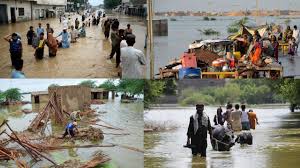ISLAMABAD, JULY14: The Monsoon Season 2024 early onset with above-normal rainfall and precipitation is posing a threat to the agriculture sector, facing crop inundation and urban flooding risk in the megacities of the country.
“Monsoon usually begins at the start of July every year; however, it started on June 27–28 in Pakistan this year. The monsoon begins in Nicobar and the Andaman Islands, advances towards India, and finally covers Pakistan. Monsoon as a whole began 2–3 days earlier than initially projected in the Nicobar and Andaman Islands,” a senior official of the National Disaster Management Authority (NDMA) told APP while elaborating on the prevailing phenomenon of monsoon season in the region with its increasing intensity every year.
He said Pakistan, as a whole, is among the countries most impacted by climate change and the fifth most vulnerable country susceptible to the devastating impacts of climate change.“Northern areas, including KP and GB, as well as Balochistan, are more at risk of climate-change-induced hazards because of their geography,” he added.
According to the National Emergencies Operations Centre (NEOC) timely projections, in Punjab, cities like Lahore, Rawalpindi, Faisalabad, and Gujranwala frequently experience urban flooding. Khyber Pakhtunkhwa’s (KP) areas, such as Peshawar, Swat, Abbottabad, Dir, Manshera, and Kohistan, face flash floods and landslides.
Upper Sindh, including cities like Sukkur and Larkana, Karachi, Hyderabad, etc., can experience heavy rains and flooding. Balochistan: The northeast and eastern parts, such as Dera Ghazi Khan’s hill torrents, are susceptible to flash floods. Gilgit-Baltistan (GB) is prone to landslides and disruptions due to heavy rainfall. However, Kashmir is vulnerable to landslides, flash floods, and infrastructure damage in areas like Muzaffarabad.
The NDMA official underlined that excessive rainfall can inundate fields, leading to crop losses, especially for water-sensitive crops like wheat and cotton. However, heavy rains can wash away topsoil, reducing soil fertility and negatively affecting future crop yields, he said, adding, “Erratic rain patterns can disrupt the agricultural calendar, delaying planting and harvesting times, which can reduce crop quality and yield. Increased humidity and standing water create favorable conditions for pests and diseases, further harming crops.”
Moreover, persistent heavy rains can cause waterlogging, damaging the root systems of crops and leading to poor plant health and lower yields. Flooded roads and infrastructure can delay the transportation of agricultural goods, leading to post-harvest losses, he added.
Monsoon weather, he said, in South Asia is primarily generated by the differential heating of land and sea. “In summer, the land heats up faster than the ocean, creating low-pressure zones that draw in moist air from the Indian Ocean, leading to heavy rains. Over the past two decades, climate change has intensified the monsoon, causing more erratic and extreme rainfall patterns, with increased instances of both severe droughts and floods. Deforestation and urbanization have also disrupted natural drainage systems, increasing the intensity and impact of monsoon rains,” he added.
He went on to mention that rising global temperatures due to climate change have intensified the water cycle, leading to more extreme and unpredictable rainfall. The rapid urban development disrupts natural water drainage systems, leading to increased runoff and flooding, whereas the loss of forest cover reduces the land’s ability to absorb rainfall, increasing surface runoff and soil erosion, he added.
“Warmer ocean temperatures enhance the evaporation rate, leading to more moisture-laden air and heavier rainfall. Shifts in global wind patterns and atmospheric pressure systems can alter the timing, intensity, and distribution of monsoon rains. These factors combined have led to more frequent and severe monsoon-related events in the region,” the official explained.
He pointed out that the variation in rain and weather patterns in South Asia is both historic and increasingly novel. Monsoon variability has always been a characteristic feature of the region’s climate, influenced by natural factors like El Niño and La Niña events as well as the Indian Ocean Dipole (different weather transitions causing shifts in weather from warmer to colder seasons) and other oceanic and atmospheric oscillations.
However, in recent years, the intensity and unpredictability of these variations have escalated, largely due to human-induced climate change. Rising global temperatures, increased greenhouse gas emissions, and environmental degradation have increased the frequency and severity of extreme weather events, making the current changes more rapid compared to historical patterns, he added.
To tackle the extraordinary shifts in weather patterns, he said there is an urgent need to enhance early warning systems for more accurate and timely predictions of monsoon rains.The NDMA has established a Provincial Coordination Cell for robust coordination with provincial disaster management authorities (PDMAs) and provincial departments for effective implementation of response plans and policy interventions, he added.
The NDMA’s National Institute of Disaster Management (NIDM) conducted local simulation exercises for local authorities, non-governmental organizations (NGOs), and the community to enhance preparedness. The Authority has launched extensive awareness campaigns in collaboration with the Ministry of Information and Broadcasting and the Ministry of Climate Change about monsoon safety and preparedness by utilizing all multimedia platforms to reach a wider audience, including radio, TV, and online media.
NDMA is providing real-time updates on monsoon conditions and warnings through mobile alerts, social media, and the NDMA’s Mob application (Pak NDMA Disaster Alert). The NDMA’s smart application provides users with real-time updates on monsoon conditions, alerts, and safety guidelines. It features interactive maps showing affected areas, shelters, and evacuation routes and includes a reporting feature for users to report incidents or seek assistance, he said.
The NDMA web portal hosts comprehensive resources on monsoon preparedness, including guidelines, advisories, and educational materials, and provides access to historical data and forecasts for better planning and decision-making. The NDMA uses all social media platforms and has recently launched its WhatsApp channel ‘Tayyar Pakistan’ to enhance its broader audience reach.
